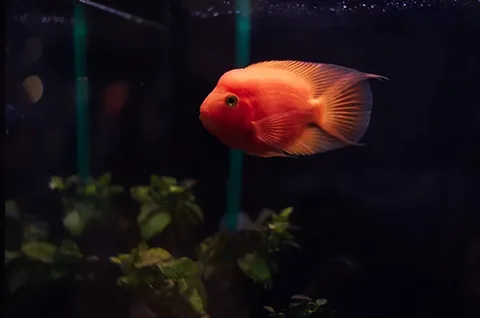Renowned for their bright coloration, funny temperament, and distinctive body form, Blood Parrot Cichlids are among the most sought after hybrid aquarium fish. Though they are certainly adorable, they are not easiest to look after mostly since their welfare and health depend closely on good water quality. Knowing the particular environmental demands of these vibrant, exotic fish is vital if you are contemplating including them in your tank. For Blood Parrot Cichlid, this manual goes over the finest water circumstances so that you can provide them with a peaceful and healthy living arrangement.
Comprehension of Blood Parrot Cichlids means
In the nature, blood Parrot Cichlids do not exist. Usually synthesized by crossing the midas cichlid (Amphilophus citrinellus) and the redhead cichlid (Paraneetroplus synspilus), they are a manmade hybrid. Their hybrid characteristic lets them carry features from every parent, including a compressed body form and a beaklike mouth. These special characteristics might make them more exposed to stress and subpar water quality.
Why water quality is important
Your Blood Parrot Cichlid’s health, color, activity level, and life span all depend directly on water quality. Substandard conditions might cause to:
An immune system frail from stress.
Ich and fin rot as well as other diseases epidemic.
insufficient color definition and growth
Shorter life span
The first step in proper Blood Parrot Cichlid maintenance is to keep perfect water quality.
water hardness level
Advised range:
6 to 18 dGH (from average soft to moderate hard)
The amount of minerals including calcium and magnesium in the water is reflected in its hardness. Somewhat flexible, Blood Parrots like hardness levels in the middle.
Monitor hardness by way of a GH test kit.
Should your water be too soft, think of adding a little crushed coral.
Use reverse osmosis (RO) water combined with tap water if your water is too hard.
Levels of ammonia, nitrites, and nitrates
Tracking of these three chemical compounds is absolutely important:
0 ppm of ammonia
Nitrite: 0 parts per million.
Nitrogen: Less than 40 ppm (ideally less than 20)
Even in tiny quantities, ammonia and nitrite are quite poisonous; over time, nitrate accumulation may also damage your fish.
hints:
Cycle your tank before you introduce any fish.
Let live plants assist in nitrates capture.
Overfeeding—too much food turns into damaging chemicals.
Filtration and water flow
Given the amount of waste produced by Blood Parrot Cichlid, a powerful and effective filtration system is absolutely necessary.
Choose a topnotch hangonback filter or a canister filter.
Strive for a GPH (gallons per hour) rating of four to five times your tank capacity.
Keep the water moving gently to mildly. Parrots are not strong swimmers; therefore stay away from fast currents
filter media ideas:
Sponge or floss to catch trash: mechanical technology
For beneficial bacteria, organic balls or ceramic rings.
For poison elimination, activated carbon or Seachem Purigen are used in chemical media.
Tank size and water amount
Blood Parrot Cichlids would need a lot of room since they can attain 8 inches in size.
One fish requires 30 gallons minimum tank.
Recommended for two or group installation: 55+ gallons
A more stable water volume dilutes poisons more efficiently and limits aggression among tank mates.
keeping track and looking after
Consistency means everything. Develop a regular practice of water testing and adjustment.
compulsory aids:
fish tank thermometer
preferredly liquid test kits for nitrogen, pH, ammonia, and nitrites.
Gravel vacuum beads
scraper of algae
waterless conditioner
Establish a maintenance schedule to assist you keep your water changes, test days, and filtration cleaning on track.
Typical water problems
Cloudy water typically results from bacterial overfeeding or a bloom. Correct with less feeding and water changes.
Excess light and nutrients will cause algae growth. Lower feeding and change lighting schedule.
Risen nitrogen: Created by not enough water changes or overstocking. Add living plants and raise water change frequency.
Conclusion
Lovely, interactive fish Blood Parrot Cichlids can live for more than a decade with proper maintenance. Although their distinct characteristics make them sensitive to bad water conditions, a wellcared aquarium with the right temperature, pH, hardness, and cleanliness will help them to be healthy and vivid. Observation, regularity, and some patience will help you to create for your Blood Parrots the perfect aquatic habitat where they will thrive for many years.


